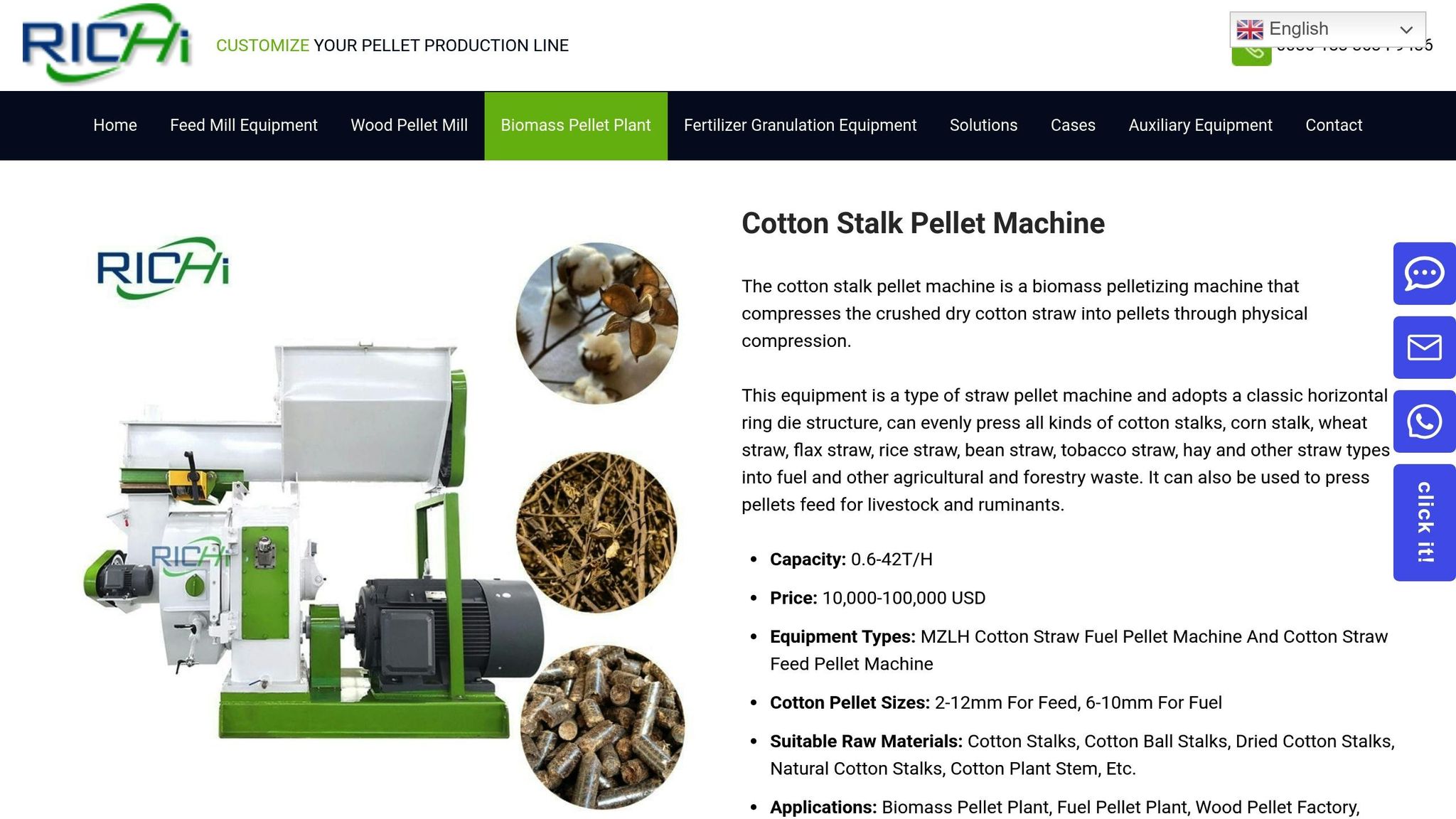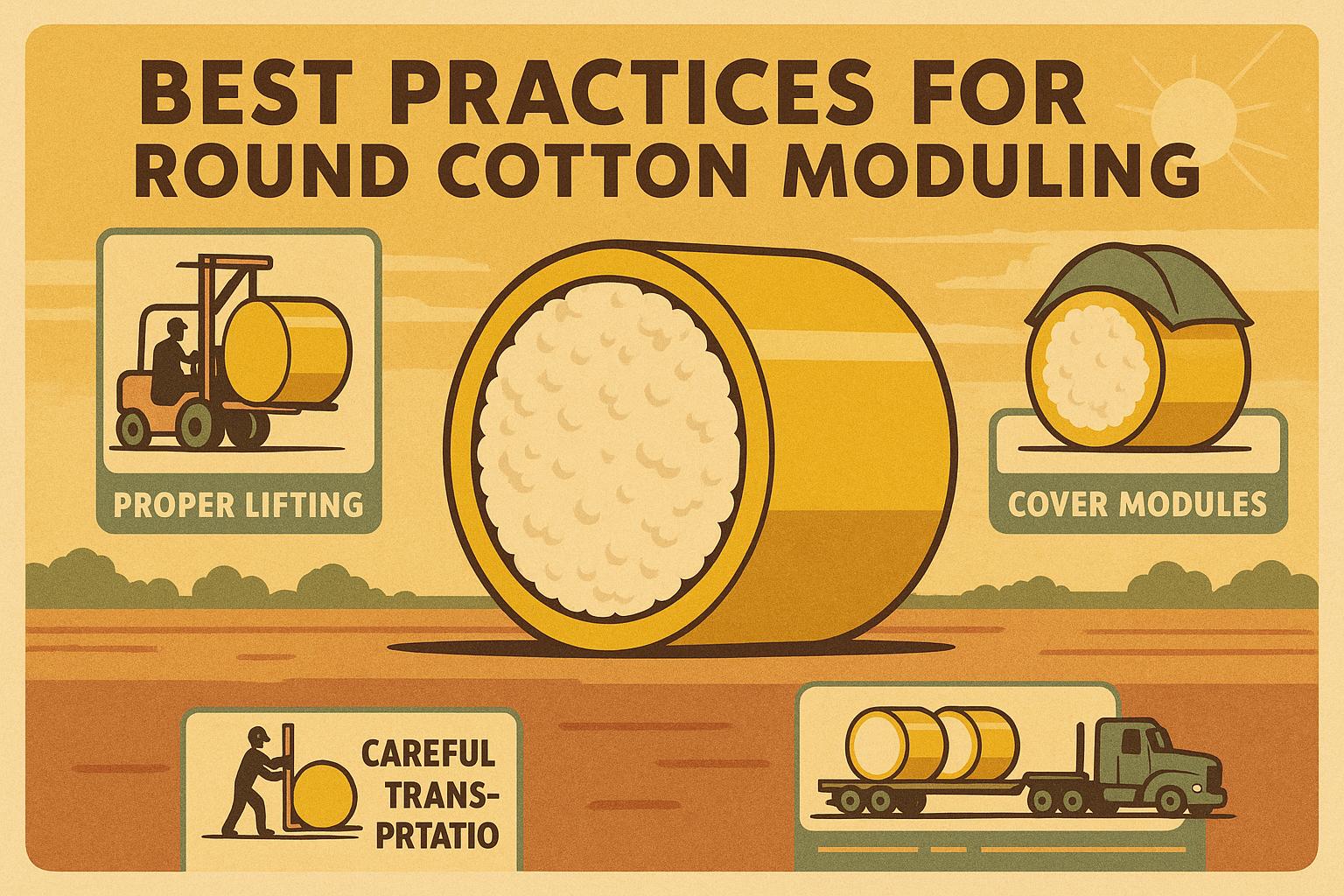Turning cotton gin waste into fuel pellets is a smart way to manage waste while creating a renewable energy source. This process not only reduces landfill use and disposal costs but also provides a potential revenue stream for cotton producers. Here's what you need to know:
- What is Used? Cotton gin waste like burrs, sticks, leaves, and short fibers.
- Why Do It?
- Reduces waste disposal costs.
- Offers a renewable energy source.
- Creates an additional income stream.
- How It Works:
- Collect and prepare the waste (screening, moisture testing, size reduction).
- Grind and dry the waste to the right size and moisture level.
- Form pellets using a pellet mill at specific temperature and compression settings.
- Properly store and transport pellets to maintain quality.
This method is suitable for both small-scale and large-scale operations, making it a flexible option for cotton gin facilities looking to improve efficiency and sustainability.
Cotton Pellet Machine | Biomass Pellet machine | Animal Feed ...

Cotton Gin Waste Basics
Cotton ginning generates various types of waste as fibers are separated from seeds and other plant materials. Knowing the different waste types helps highlight their potential when transformed into fuel pellets.
Types of Cotton Gin Waste
Cotton gin waste includes several components:
- Gin Trash: A mix of leaves, sticks, and other plant debris
- Cotton Burrs: The hard outer shells of cotton bolls
- Motes: Short fibers and immature seeds
- Lint Cleaner Waste: Fine particles and additional short fibers
The exact makeup of this waste depends on factors like harvesting methods, weather conditions, and the settings of ginning equipment. Identifying these components is key to determining the best approach for conversion.
Turning Waste into Fuel Pellets
Each type of waste contributes unique energy characteristics to fuel pellets, offering several benefits:
- High Energy Output: Fuel pellets provide strong heating performance, comparable to other biomass fuels. Burrs, in particular, have the highest energy content.
- Efficient Production: Automated systems streamline pellet production, making it a labor-light process while making full use of waste materials.
- Cost Savings: Converting waste into fuel pellets reduces disposal expenses and creates new revenue opportunities, with potential returns of up to 30% on processing investments.
Making Fuel Pellets: Step by Step
Waste Collection and Preparation
Start by collecting cotton gin waste directly from the ginning process. Store it in a covered area to maintain a moisture content of 12–15%.
Key preparation tasks include:
- Screening: Remove metal fragments and other non-organic debris.
- Moisture testing: Use a moisture meter to ensure proper levels.
- Size assessment: Make sure material chunks are no larger than 2 inches.
Grinding and Drying
Grind the waste into uniform particles, about 1/8 inch in size, to ensure consistent pellet quality.
Keep these parameters in mind:
- Grinder speed: 1,750–2,000 RPM
- Screen size: 3/16 inch
- Feed rate: 2–3 tons per hour
- Target moisture: 8–10% after drying
Once the material is evenly ground and dried to the right moisture level, it's ready for pellet formation.
Pellet Formation
Feed the material through a die with an 8:1 compression ratio. Friction during this process heats the material to 150–200°F, with the ideal die temperature being 180–190°F. Aim for a production rate of 1–1.5 tons per hour. Afterward, allow the pellets to cool for 15–20 minutes.
Storage and Handling
After the pellets have cooled, proper storage and handling are critical:
- Use covered facilities to protect pellets from weather.
- Store in ventilated spaces with 40–60% relative humidity.
- Place pellets on elevated platforms at least 6 inches off the ground.
For transportation, use sealed containers or covered trucks to avoid moisture exposure. For best results, store pellets for no more than six months.
| Storage Parameter | Recommended Range |
|---|---|
| Temperature | 50–80°F |
| Humidity | 40–60% |
| Stack Height | Max 12 feet |
| Floor Clearance | Min 6 inches |
sbb-itb-0e617ca
Required Equipment
The equipment you need will vary based on the size of your operation and the specific production requirements. Smaller setups usually rely on a pellet mill, along with drying and grinding machines. On the other hand, larger facilities often require fully integrated systems with automated, continuous production capabilities.
For smaller-scale production, a simple setup with a pellet mill, drying machine, and grinder is typically sufficient. In contrast, larger operations benefit from advanced systems that streamline production. It's a good idea to consult with machinery suppliers to determine the best equipment for your needs.
Results and Practical Tips
Waste vs. Pellet Properties
Turning cotton gin waste into fuel pellets significantly improves its usability. Raw cotton gin waste tends to be low-density, irregularly shaped, and has inconsistent moisture levels, making it tricky to manage and store. On the other hand, fuel pellets created from this waste are denser, have controlled moisture levels, and are uniformly cylindrical. These changes make the pellets easier to handle, store, and transport while also boosting their energy density.
Production Best Practices
To produce high-quality pellets efficiently, keep these tips in mind:
- Maintain consistent moisture levels to ensure proper pellet binding.
- Grind the waste evenly to achieve uniform pellet shapes.
- Watch for issues like crumbling or uneven textures and adjust grinding, drying, or pelletizing processes accordingly.
Conclusion
Turning cotton gin waste into fuel pellets is a practical way for cotton producers to tackle waste management while creating an energy resource. This method not only simplifies waste disposal but also boosts operational efficiency.
By converting waste into fuel pellets, producers can cut costs and open up a new revenue stream. These pellets are easy to store and transport, making better use of facility space.
This process also supports eco-friendly farming practices by reducing landfill use and eliminating the need for field burning. The pellets offer a cleaner-burning energy option compared to traditional fuels.
While there are upfront costs for equipment and training, the long-term benefits outweigh them. The process is flexible, allowing facilities of all sizes to adopt it, whether they operate on a small or large scale.


